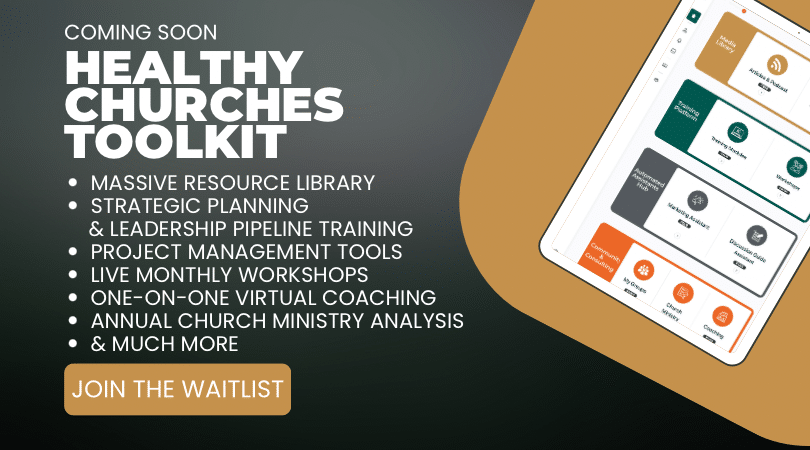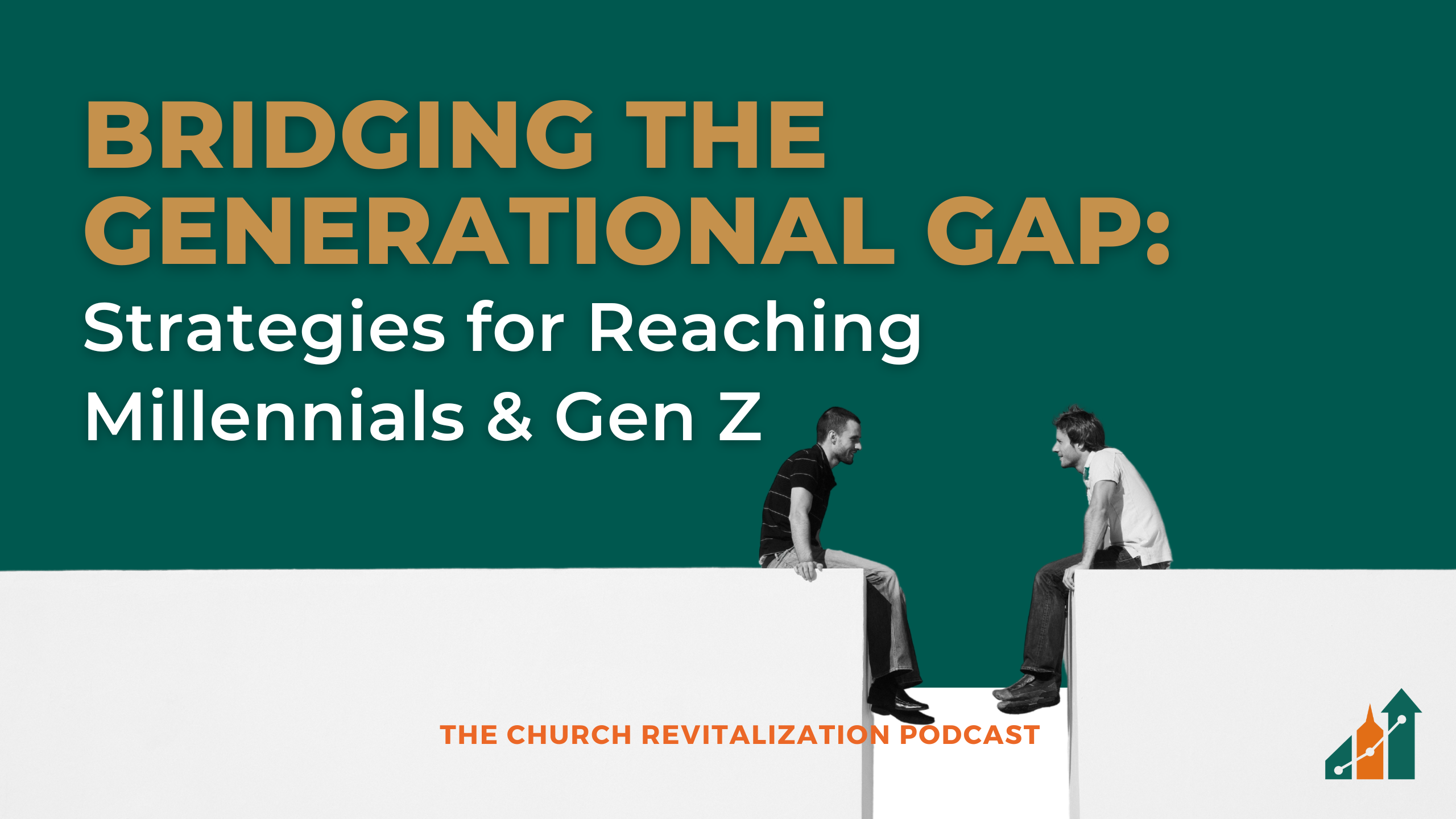The Church Revitalization Podcast – Episode 186
A common refrain in churches we work with is: “We want to be a multigenerational church!” But when we show up to services on Sunday morning, we see a lot of white hair and hear too few babies. Desiring to minister across generations is a holy desire, but it requires that you take time to think like a missionary and truly understand the next generation.
One common misconception is assuming that Millennials and Gen Z are essentially the same, and that strategies that work to reach one generation will translate into the other. While you don’t need to develop entirely separate ministries to reach Millennials and Gen Z, it’s important to understand their differences so that as you develop your strategies, you can account for those differences.
Millennials and Generation Z are distinct generations, each with their own unique set of values, motivations, and felt needs. Millennials are generally defined as being born between 1981 and 1996. This means that, at the time of this writing, every Millennial is an adult–often well into their career and family life. Millennials are not the recent college grad or the nerdy teenager in the corner! I often hear older peoplebemoan about Millennials in a way that suggests that they are young and immature–not middle aged and nearing the prime of their career. In terms of their values, Millennials are often characterized as tech-savvy, environmentally conscious, and valuing work-life balance.
On the other hand, Gen Z are people born between 1997 and 2012, and are known for being digitally native, socially aware, and valuing individuality. At the time of this writing, all but the youngest of Gen Z are middle-school, high-school, and young adults whose minds are still being formed. From a missional perspective, this means that the Church has a critical opportunity to shape Gen Z and influence them towards Christ in ways that are harder with unchurched Millennials.
In this article, I want to outline a few key differences between the values and motivations of these two generations so that you can better understand and relate to Millennials and Gen Z. Then, we’ll explore three key strategies you can use to reach these generations and become the multigenerational church you dream of being.
Subscribe below to never miss an episode.
Key Differences Between Millennials and Gen Z
Technology Adoption:
Millennials are considered the pioneers of the digital age, having witnessed the rapid growth of tech and the internet during their formative years. In contrast, Gen Z grew up immersed in the digital world, never knowing a time without smartphones or social media. This has shaped their interaction with technology, with Gen Z being even more reliant on it.
Communication Preferences:
Millennials often appreciate a blend of digital and face-to-face communication. They value personal connections supplemented by digital interactions, not replacing them. Gen Z, on the other hand, is more accustomed to digital-first interactions, and prefers communicating primarily through social media platforms and messaging apps.
Job Stability:
Most Millennials were deeply impacted by the Great Recession, since they graduated from college or graduate school during that time period. As a result, they often prioritize job security and stability. Despite this, Millennials have a strong desire for work-life balance, and advocate for reforms that prevent burnout. Gen Z is more focused on finding work that aligns with their passions and individual expression, even if it means changing jobs frequently or pursuing non-traditional career paths. It’s Gen Z that gets highlighted when social media posts go viral displaying an exhaustion with what previous generations would consider normal workloads.
Financial Outlook:
Millennials are known for being more cautious with their finances, focusing on paying off student loans and dealing with the economic challenges they’ve experienced. Gen Z tends to be more optimistic and entrepreneurial, looking for ways to create their own opportunities and build wealth.
Social Issues:
Ministry Leaders have a greater degree of influence because their explicit role is to lead others in some way towards a deeper relationship with the Lord and greater understanding of Him. This can occur through various roles from small group leaders to worship team members. Regardless of the ministry, the function of a Ministry Leader is to lead other people to Jesus in concrete ways.
Because their influence is greater, the expectation for spiritual mentorship is greater, too. Therefore, spiritual mentorship for Ministry Leaders looks like a consistent pursuit of living out the fruit of the Spirit in everyday life. While the manifestation of the fruit is a work of the Holy Spirt, the Apostle Peter says explicitly in 2 Peter 1:5 that believers can “make every effort to supplement your faith with virtue.” This isn’t a form of legalism. It’s an acknowledgement that if we want to bear spiritual fruit, we have to cultivate good spiritual soil. This is the expectation for Ministry Leaders: that they would take ownership of the spiritual soil of their heart, so that the Spirit might effectuate good spiritual fruit.
Three Strategies for Reaching Millennials and Gen Z:
Multigenerational Groups:
Churches often sabotage their vision for multigenerational ministry because they have a model for discipleship that mandates generational silos. The best way to combat this is to institute multigenerational groups, both on and off campus. A successful multigenerational small group ministry engages and connects individuals of all ages, fostering an environment of learning, growth, and unity.
Choose study materials that appeal to across generations and incorporate different learning styles. Incorporate a mix of Bible studies and ensure everyone has opportunities to dialogue. Recognize that a classroom-like environment is unlikely to appeal to Millennials or Gen Z. So make sure that the room itself is primed for personal interaction. Allow different members to take on leadership roles within the group, such as leading prayer and facilitating discussions. This helps to develop the next generation of leaders within the church in an organic way.
Additionally, your church could add a service component to your groups strategy. Invite members to work together on service projects or even go on mission trips. This fosters intergenerational interaction and creates an environment where older generations can disciple the younger generations.
Innovative Uses of Technology:
Baby Boomers and Gen X can better leverage technology to reach Millennials and Gen Z by embracing digital platforms and recognizing their value in fostering connection and communication. The pandemic forced many churches to take quantum leaps forward in their use of technology, but in many ways, it was slapdash and born of necessity, not intentionality. It’s great if you have a live-streamed service and a digital bulletin or connect card. These are fantastic first steps towards embracing technology. However, there are some more creative and innovative ways that digital tools can engage the next generation.
Before we dive into a few specific ideas, here are some principles to keep in mind as you create your unique digital strategy. First, take the time to learn about new technologies. Rather than blow them off or ignore them, take the time to learn how different platforms and tools work. Explore if there is a practical way you could integrate its functionality into how you do ministry that would actually improve your ability to reach the next generation.
Using tools simply to be on the cutting edge isn’t beneficial, either. So be open minded, but think practically. Ask: “Is this a tool we can easily integrate into our ministry and it could demonstrably improve our ability to reach unchurched Millennials and Gen Z people in our community?” Often, including younger members in decision-making and planning can improve your ability to answer that key question.
Here are a few, simple ideas to use technology in innovative ways that are outside the norm:
- Digital Prayer Walls: Set up an online prayer wall where church members can post and respond to prayer requests. This creates a supportive community where people can easily share their burdens and celebrate answered prayers.
- YouTube Sermon Series: Create a series of short, engaging sermons on YouTube that cover relevant topics for Millennials and Gen Z.
- Instagram Takeovers: Allow different members to “take over” the church’s Instagram account for a day, sharing their testimony and experience at your church
- Interactive Sermon Notes: Share sermon notes with embedded multimedia content, such as images, videos, or links to additional resources, to enhance understanding and engagement.
- Online Workshops: Offer online workshops on faith-related topics, such as biblical history, prayer, or spiritual disciplines, enabling members to grow and learn together.
- Spiritual Growth Tracker: Create an online platform where members can track their spiritual growth activities, such as prayer, Bible study, and acts of service, fostering accountability and encouragement.
- Worship-inspired Spotify Playlists: Curate and share Spotify playlists with worship music, encouraging members to engage with uplifting content.
- Faith-based Fitness Challenges: Create and share faith-based fitness challenges, such as “Walk and Pray,” encouraging members to care for their physical and spiritual health (similar to Apple’s “Audio Workouts”).
These are just a few ideas that will hopefully spark your imagination as you dream about how you can better leverage technology to engage Millennials and Gen Z–both those in your church and those who are unchurched in your community.
Mentorship Programs:
As we talked about in a recent article, all leaders are spiritual mentors. The need for mentorship in our culture is immense, and the Church has a built-in environment to foster mentorship. However, most churches fail to encourage these kinds of relationships, despite the clear opportunities to do so.
If you follow the earlier advice to set up multigenerational groups, the natural next step is to leverage those same groups to facilitate one-to-one mentorship. Within the groups, match up mentors and mentees based on their interests, strengths, and areas they want to grow in. You can use a simple survey or questionnaire to help find the best pairings, or just rely on the organic relationships that should be fostered in a multigenerational group.
Once the pairs are set, provide some guidance and resources to help them build a strong relationship. For example, suggest they meet regularly, maybe once or twice a month, to discuss specific topics like faith, career, or personal growth. Provide outlines or coaching templates that ensure that they have quality conversations, and not just spend their time talking about ancillary topics.
Finally, keep track of the ministry’s progress by regularly checking in with the mentor-mentee pairs and gathering feedback. This way, you can celebrate their successes and make improvements to the ministry as needed. By following these steps, you can create a meaningful mentorship program that brings generations together and strengthens their faith community.
Bridging the generational gap and reaching Millennials and Gen Z is crucial for the growth and sustainability of your church, especially if you have a vision for being a multigenerational church. By creating multigenerational small groups, leveraging technology, and cultivating mentorship programs, you will be better positioned to reach the next generation. By engaging the unique perspectives, talents, and passions of Millennials and Gen Z, your church can ensure a vibrant and thriving future as you continue to live out your Great Commission mission.
BONUS: Watch this episode on YouTube.


Scott Ball is the Vice President and a Lead Guide with The Malphurs Group. He lives in East Tennessee with his wife and two children. (Email Scott).

